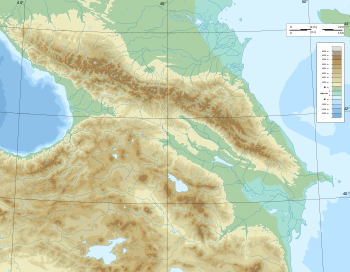| Battle of Basiani | |||||||
|---|---|---|---|---|---|---|---|
| Part of the Georgian–Seljuk wars | |||||||
 The plan of the battle | |||||||
| |||||||
| Belligerents | |||||||
|
Sultanate of Rum Mengujekids | |||||||
| Commanders and leaders | |||||||
|
David Soslan Zakaria Mkhargrdzeli Shalva Akhaltsikheli Ivane Akhaltsikheli Ivane Mkhargrdzeli |
Süleymanshah II Tughril Shah Fahrettin Behramşah | ||||||
| Strength | |||||||
| 65,000–90,000 | 150,000–400,000 | ||||||
| Casualties and losses | |||||||
| Heavy | Heavy | ||||||
| Georgian–Seljuk wars | |
|---|---|
The Battle of Basiani was fought between the armies of the Kingdom of Georgia and the Seljukid Sultanate of Rum in the Basiani Valley, 60 km north-east of the city of Erzurum in what is now northeast Turkey. The date of the battle has been debated, but recent scholarship tends to favor the years 1203 or 1204. According to modern Turkish historians, the site of the battle is usually identified as the castle of Micingerd (Mazankert).
Date
According to the contemporary Muslim chronicler Ibn Bibi, the battle took place in 598 AH (October 1, 1201 – September 19, 1202). Modern scholars date the battle variously between 1202 and 1206: 1202, 1203, 1203/1204, 1204, 1204/1205, 1205, 1206 but in recent times preference has been given to around 1203, or between 1202 and 1204.
Background
At the end of the 12th century, the Sultanate of Rum plunged into chaos due to Turkmen raids, Crusades and fierce power struggles among the descendants of Kilij Arslan II (1156–1192). In 1197, Rukn ad-Din Suleiman Shah, the fifth son of Kilij Arslan II, captured Konya and forced his brother Kaykhusraw I to leave the country and go into exile in Constantinople. Rukn ad-Din began a policy of expansion, challenging Byzantium, Armenian Kingdom of Cilicia and Kingdom of Georgia, uniting much of Anatolia under his rule.
The rise of the Georgian kingdom under King David IV the Builder continued under the reign of Queen Tamar, who managed to defeat a large Muslim coalition at the Battle of Shamkor in 1195.
Alarmed by Georgia's success, Sultan Rukn ad-Din Suleiman Shah, gathered the Muslim Anatolian beyliks against Georgia. The interests of Georgia and the Sultanate of Rum clashed on the southern coast of the Black Sea, where both sought to take advantage of Byzantine weakness and establish their own footholds.
Sultan Rukn ad-Din prepared for war to weaken the power of Christian Georgia and to conquer it. Between 1201 and 1203, Rukn ad-Din with detachments under the command of his brother, Mughis ad-din Tughril Shah of Elbistan, Mengujekid Bahram Shah of Erzincan, possibly with the help, of the Harput Artuqids as well as local Turkmen warriors, captured Erzurum and replaced the vassal of Georgia, Saltuk, with his brother Mughisuddin Togrul Shah.
Rukn ad-Din's messenger delivered letters to Tamar, demanding surrender and threatening extermination of disobedient Christians. Stating that "every woman is simple-minded...you...simple-minded queen...murderer and tax collector of Muslims." Tamar's first response was polite: "You rely on gold and numerous warriors, I... on the power of God".
The ambassador also transmitted an oral afterword: Rukn ad-Din would make Tamar his wife if she accepted Islam, otherwise he would make her his concubine. Zakaria II Mkhargrdzeli hit the ambassador, and told him: "If you were not an ambassador, it would be proper to cut out your tongue first and then cut off your head" and pointed to the expectation of Rukn ad-Din's divine judgement carried out by Georgians.
Battle

Blue circle=Capital
Black dot=Georgian held cities and fortresses
Red dot=Sultanate of Rum
X=Major battle
The Georgian army, numbering 65,000–90,000 troops, was ready for battle within ten days, and as soon as Rukn ad-Din's envoy left, it entered the battlefield under the command of David Soslan. It was composed of Zakaria and Ivane Mhargrdzeli, Shalva and Ivane Akhaltskheli, and other famous commanders. "The Story of Queen Tamar" describes how the army assembled in Vardzia before moving to battle, and how Tamar addressed the troops from the balcony of the church. As Tamar's chronicle states, "Tamar herself walked at the head of her troops, barefoot, with her face washed with tears."
Rukn ad-Din gathered his troops: he was helped by his brother-in-law, the Emir of Erzincan, but he was let down by Erzurum, who remembered that he was a vassal of Georgia. According to Muslim (Arabic and Turkish) sources he had 400,000 troops. Their numbers vary from 150,000 to 400,000 troops.
Summoning his allies, Rukn ad-Din's massive army moved towards the borders of Georgia and encamped near Basiani. The Georgian army was deployed strategically, with western (Abkhaz-Imereti) and eastern (Kartli, Hereti and Kakheti) units on the sides and a substantial force in the centre of 40,000 warriors under the command of Shalva and Ivane Akhaltsikheli, with Zakaria II Mkhargrdzeli commanding the vanguard. During the night, the Georgians first made a surprise attack with their advance group and caused confusion among the enemy troops. The Sultan managed to gather his forces and counterattack, but his army was surprised by coordinated flank attacks that defeated his troops.
Rukn ad-Din's forces fought so determinedly that the Georgian horsemen had to fight on foot and faced defeat until other Georgian regiments led by David Soslan struck from the flank and surrounded the Turks. Historian Ibn Bibi blamed the Rukn ad-Din's standard bearer's horse, which slipped and fell, for starting the rumour of Rukn ad-Din's death and demoralising his army.
Aksaray attributes the defeat to the Seljuks being ambushed, whereas, the Georgian chronicle emphasises the courage of the Georgian soldiers and God's help, although it admits that the Georgians were almost defeated at one point.
Aftermath

The battle of Basiani inflicted heavy casualties on both sides. Rukn ad-Din was forced to retreat back to Erzurum and the Georgians captured the battle banners. Many of the Sultan's allies were captured by the Georgians, among them the Emir of Erzincan, an ally of the Sultan.
In the "Historical Collection", Armenian historian Vardan Areveltsi boasts that David "filled Georgia with captivity and plundering Turks". In fury for attacking a former vassal, Queen Tamar ordered that Emir of Erzincan (Bahramshah) be sold into slavery for the price of one iron horseshoe.
The victory at Basian secured the Georgian advantage in the region. Using her success in this battle, Queen Tamar annexed Arran and Dvin, also subjugated the Emirate of Kars, the Shah-Armenids and the emirs of Erzurum and Erzincan.
Despite the defeat, Tughril Shah, brother of Sultan Rukn ad-Din, retained control of Erzurum. However, later in 1206, the Georgians captured recalcitrant cities of Erzurum and Kars.
After the victory, Archbishop Anton Gnolistavisdze, acquired an Arabic medical treatise, which he translated into Georgian, creating the "Book for Doctors" (Tsigni saakimoi), one of the earliest works of Galenic medicine in Georgia.
References
- Lortʻkʻipʻaniże, Mariam. Georgia in the XI-XII Centuries. Georgia, Ganatleba Publishers, 1987.
- ^ Peacock 2006, p. 135.
- ^ Rayfield 2012, p. 114.
- ^ Javakhishvili, Book 2, p. 247
- ^ Mikaberidze 2007, p. 186.
- ^ Lordkipanidze 1994, p. 162.
- ^ Salia 1983, p. 180.
- ^ Mikaberidze 2011, p. 196.
- Eastmond 1998, pp. 121, 133, 136.
- ^ Baumer 2023, p. 27.
- Peacock & Yildiz 2015, p. 78.
- Peacock 2006, p. 133.
- ^ Rayfield 2012, p. 113.
- Eastmond 1998, p. 133.
- Eastmond 2017, p. 213.
- Rayfield 2012, pp. 113–114.
- Eastmond 1998, p. 121.
- Lordkipanidze 1994, p. 62.
- ^ Peacock 2006, p. 134.
- Eastmond 1998, p. 136.
- Eastmond 2017, p. 85.
- Mikaberidze 2007, p. 187.
- Eastmond 2017, p. 73.
Sources
- (in Georgian) D. Ivane Javakhishvili, (1983), ქართველი ერის ისტორია (History of Georgian Nation), Archived 2019-09-27 at the Wayback Machine Tbilisi: Georgia, USSR.
- Rayfield, Donald (2012). Edge of Empires, a History of Georgia. London: Reaktion Books. ISBN 978-1-78023-070-2.
- (in Georgian) Melikishvili, Giorgi et al. (1970), საქართველოს ისტორიის ნარკვევები (Studies in the History of Georgia), Vol. 2. Tbilisi: Sabch’ota Sakartvelo.
- (in Turkish) Osman Turan, Selçuklular Zamaninda Türkiye, Istanbul, 1971
- (in Russian) V. Dondua et al. (transl., 1985), Жизнь царицы цариц Тамар (The Life of the Queen of Queens Tamar), Commentaries by N. Berdzenishvili. Tbilisi: Metsniereba
- Baumer, Christoph (2023). History of the Caucasus. Bloomsbury Publishing. ISBN 9780755636303.
- Eastmond, Antony (2017). Tamta's world: the life and encounters of a medieval noblewoman from the Middle East to Mongolia. Cambridge: Cambridge University Press. ISBN 978-1-107-16756-8.
- Eastmond, Antony (1998). Royal imagery in medieval Georgia. University Park: Pennsylvania State University Press. ISBN 978-0-271-01628-3.
- Lordkipanidze, Mariam (1994). "Georgia in the 11th–12th centuries". Essays on Georgian history. Tbilisi: Metsniereba. ISBN 978-5-520-01547-5.
- Mikaberidze, Alexander (2007). Historical dictionary of Georgia. Historical dictionaries of Europe. Vol. 50. Lanham, Maryland: Scarecrow press. ISBN 978-0-8108-5580-9.
- Mikaberidze, Alexander (2011). "Basian, Battle of (1203)". Conflict and conquest in the Islamic world: a historical encyclopedia. Santa Barbara, California: ABC-CLIO. ISBN 978-1-59884-336-1.
- Peacock, Andrew (2006). "Georgia and the Anatolian Turks in the 12th and 13th centuries". Anatolian Studies. 56: 127–146. doi:10.1017/S0066154600000806. ISSN 0066-1546. JSTOR 20065551. S2CID 155798755.
- Salia, Kalistrat (1983). "Battle of Basiani (1205)". History of the Georgian nation. Paris: N. Salia. pp. 180–181.
- Peacock, A.C.S.; Yildiz, Sara Nur, eds. (2015). The Seljuks of Anatolia: Court and Society in the Medieval Middle East. I.B. Tauris.
